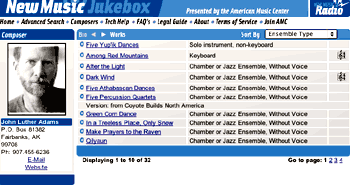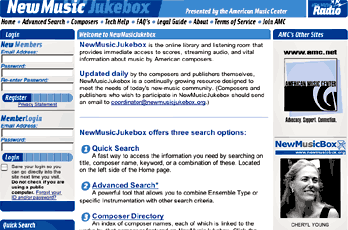

 |
 |
NewMusicJukebox: Contemporary American Music Online
|

|
|
Detail from NewMusicJukebox web site. |
Whether a contemporary American composer can be categorized as a kitchen appliance is just one intriguing development challenge that the American Music Center (AMC) tackled in creating NewMusicJukebox, a portal web site for Contemporary American music. The site offers access to audio recordings, downloadable music scores, and information on new music artists. Its creators describe it as an online marketplace where producers, performers, orchestra administrators, concert programmers, movie directors, choreographers, students, and audience members can easily hear music 24/7 by American composers.
Larry Larson, AMC board member, and Richard Kessler, AMC Executive Director, came up with the idea for NewMusicJukebox in 1998. Almost five years later, the site made its debut to rave reviews. AMC's successful navigation of a morass of technical, design, and intellectual property issues offers inspiration for others contemplating a large scale web site to serve originating artists. Larson's advice, "Patience and stubbornness. Especially when lawyers and software engineers tell you it can't be done."
Kessler notes it is important to start with an exciting vision that fills a real need in the field. NewMusicJukebox grew out of Kessler's own frustration with easily finding sound files on the Internet by a particular contemporary American composer to send to a regional orchestra. "The composer didn't have a web site. Next, I tried the publisher's web site. There was a listing, but no audio samples. This happened to me many times and I wasn't alone. Yet, if you were searching for garage music - you could find samples." Kessler and Larson did more than grumble about the disconnect between American composers getting their music into the marketplace and the reality of what was happening on the Internet with other musical genres. They set out to bridge the gap with NewMusicJukebox.
 |
|
Detail from NewMusicJukebox homepage. |
NewMusicJukebox is closely tied to the AMC's history, identity, and information service goals. The organization was founded in 1939 with a mission to aid in the distribution of music and serve as an information clearinghouse. When AMC opened its first office on West 42nd street, it quickly became a networking site and headquarters for American music. With NewMusicJukebox and its other online ventures, AMC is taking the bold move of establishing a strong Internet presence to boost its mission. "It complemented our webzine, New Music Box, and extended our historic collection of scores and recordings which were transferred to the New York Public Library of the Performing Arts." Kessler says "A technology project will only be successful when you can say that you MUST do it to realize your mission more effectively."
Kessler and Larson stress the importance of taking the time to flesh out an idea into a workable web concept and test it with potential funders. Says Larson, "We spent a whole year talking about the idea before we wrote anything down. We envisioned what the technology could do for composers and the new music field. We asked a lot of 'what if' questions." Both Kessler and Larson emphasize the importance of not rushing into implementation.
With a well-crafted concept in hand, Larson and Kessler sought development money. They presented the NewMusicJukebox concept to potential funders who not only gave feedback, but provided seed funding. Notes Kessler, "They asked many good questions. It became clear that we needed board buy-in because the project would have a substantial impact on our resources." There were many board discussions particularly about the thorny intellectual property issues. More importantly, Larson, a board member with technology expertise, helped demystify the technology that NewMusicJukebox would eventually use.
With seed funding and organizational commitment in hand, AMC faced some major hurdles in making NewMusicJukebox a reality. The technology applications that lie beneath NewMusicJukebox were still evolving. Licensing agreements had to be created from scratch with significant input from the legal departments of publishers, recording producers, and AMC's own legal counsel. If that weren't enough, it took the AMC team many months to design a search engine interface for the database. Larson notes, "Databases are very structured. Our design challenge is that artists demand flexibility in the way they describe their work!" Notes Kessler, "If we had anticipated the road ahead, we would never have moved forward."
The administrative interface to NewMusicJukebox lets registered users (composers and publishers) upload their scores, audio files, and supplementary materials. Once added to the site, the content is accessible to NewMusicJukebox site visitors. The interface design process sparked some very interesting philosophical debates on how to describe contemporary music. Larson notes, "Our task was to build a search interface that described and classified the instrumentation of Western music in a standardized way. We quickly discovered that it was impossible." Using feedback from composers and music publishers who tested various prototypes, AMC created a search interface that could accommodate a work that included water glasses as part of its instrumentation. Adds Larson, "And still it be usable by human beings." Ultimately, the site offers two ways of searching - ensemble types and listing the actual instrumentation. A simple key word search proved to be an elegant solution to providing the open-endedness that some artists require to identify their work.
The back-end of NewMusicJukebox is scalable so it can easily integrate other applications as well as handle a larger number of transactions, composers, and works. Larson notes, "We didn't want the technology to be cheap and cheerful and outgrow it in a year. We could do what we are doing now for far less money, but we wouldn't have the ability to add-on functionality down the road." He continues, "You have to make a commitment which means investing a lot more time and money upfront. We had to maintain our credibility as we missed our original deadlines. It required explaining this complex technology in simple terms to non-technical people."
Most of the technology applications that NewMusicJukebox integrates were not developed against a hard set of variables. Notes Larson, "What could or couldn't be done was changing from month to month. For example, Internet delivery of scores. Music notation specialists have high standards for how a score looks. There were issues about how the score might render on the screen. We had music notation specialists telling us that it couldn't be done! And, then in six months later -- it could be done." Kessler and Larson observe, "Our weekly development team meetings were very much about problem solving."
Visitors to NewMusicJukebox can listen to sound files from commercial recordings as well as view or download scores. All are protected by copyright laws. NewMusicJukebox's artful navigation through the thicket of intellectual property laws is a model to other fields. Notes Kessler, "We didn't realize before we started that we needed to do a major outreach to develop relationships with composers, record producers, and publishers. Licenses didn't exist. The laws were evolving. There was no boilerplate. We had to create it!"
The case-by-case negotiations with composers, publishers, and record producers - and their legal counsel resulted in a licensing agreement that educates and empowers composers and offers multiple ways to include their material on the site. According to Kessler, a particular composer or publisher might only include a listing for the score, while others may have it available in excerpted form. Some scores, particularly shorter works, will be available in their entirety. The licensing agreement spells all this out in a ten-page terms of service document and warns artists in red ink not to hit the "I Agree" button without carefully reading and understanding the document. AMC staff are available to answer questions by phone or email and the site includes an extensive copyright and licensing Frequently asked questions.
Larson and Kessler note that it is important to find the right legal counsel and included a line item for legal fees in the budget even if some of the legal counsel is provided on a pro-bono basis.
Kessler and Larson describe building NewMusicJukebox as a "deeply reflective" process. AMC members and board members tested the administrative back-end where composers upload their materials as well as the front-end. Feedback was incorporated before a "soft launch" over the summer, 2002. Prior to a public launch in October, 2002 at Avery Fisher Hall, a last round of revisions were incorporated. The site opened to rave reviews in the New York Times, Wall Street Journal, and other publications, all managed by a public relations firm.
NewMusicJukebox still is very much a work in progress. The development team, which includes Kessler, Larson, technical specialists, music publisher liaison, and AMC staff, is turning their attention to NewMusicJukebox, Version 2. The focus will be to add many more scores and composers to the site, incorporate e-commerce functionality so that site visitors can order scores and parts for rental or purchase, and a 24/7 web radio. The back-end has been designed and built to accommodate this growth - as Larson describes it, "A pre-paid asset."
Kessler and Larson anticipate a whole new set of development headaches associated with adding to e-commerce and web radio functionality. As Kessler and Larson observe, "the potential to bring American Music to a wider audience gives us the inspiration to take on these challenges."
_________________
Beth Kanter is an independent nonprofit technology consultant and a member of the Summit Consulting Collaborative. She is a community consultant to N-TEN to help coordinate the Roundup 2002. Her other clients include the New York Foundation for the Arts where she has designed and implemented technology planning, training, professional development programs for the past eight years and the Alliance of NY State Arts Organizations where she serves as an intermediary for its E-Leadership Program, an e-learning program with Cornell University. Her web site can be found at www.bethkanter.org
National Endowment for the Arts
Contact the Web Manager